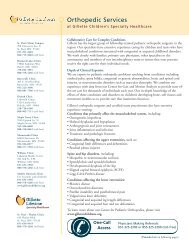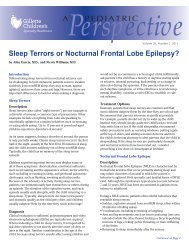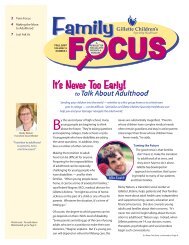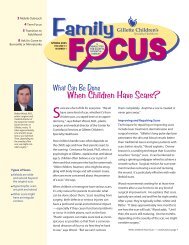Intoeing and Outtoeing: Common Concerns During Childhood
Intoeing and Outtoeing: Common Concerns During Childhood
Intoeing and Outtoeing: Common Concerns During Childhood
Create successful ePaper yourself
Turn your PDF publications into a flip-book with our unique Google optimized e-Paper software.
A<br />
Perspective<br />
PEDIATRIC<br />
November/December 2004 Volume 13, Number 5<br />
<strong>Intoeing</strong> <strong>and</strong> <strong>Outtoeing</strong>: <strong>Common</strong> <strong>Concerns</strong><br />
<strong>During</strong> <strong>Childhood</strong><br />
by Stephen Sundberg, M.D.<br />
When children begin to walk, most parents expect the child to<br />
walk “normally.” Many children, however, demonstrate some<br />
degree of intoeing (feet point inward) or outtoeing (feet point<br />
outward), which might cause concern among family members<br />
<strong>and</strong> the medical staff who care for these children.<br />
Is the child’s walk normal? Will it resolve? Does it lead to<br />
problems in adulthood? What can be done about it? You<br />
might be able to answer these common questions, ease<br />
concerns <strong>and</strong> eliminate multiple physician visits by effectively<br />
communicating with parents about the cause of the gait<br />
deviation, the natural history of the problem, <strong>and</strong> its treatment<br />
options.<br />
The evolution of gait in childhood results from a complex set<br />
of factors that ultimately result in a stable, mature gait.<br />
Progressive maturation of a growing child’s brain <strong>and</strong><br />
peripheral nervous system during the first five to six years of<br />
life means that each child’s gait gradually becomes more<br />
stable <strong>and</strong> consistent. For example, torsional changes at the<br />
level of the femur <strong>and</strong> tibia might make an immature child’s<br />
walk appear abnormal <strong>and</strong> result in frequent consultations<br />
with physicians.<br />
Natural History<br />
Explaining the natural history of a child’s skeletal<br />
development before <strong>and</strong> after birth can help guide your<br />
discussions with families.<br />
<strong>During</strong> the first five to seven weeks of intrauterine life, limb<br />
buds appear on the developing fetus. Initially, the great toe<br />
points outward. The lower leg <strong>and</strong> foot gradually rotate, so<br />
that the tibia <strong>and</strong> femur are rotated internally at birth.<br />
Intrauterine molding can result in external rotation of the hip’s<br />
soft tissues. This leads to a physiologic hip external rotation<br />
<strong>and</strong> flexion contracture at birth. This soft-tissue contracture<br />
masks the underlying normal femoral anteversion (internal<br />
rotation of the proximal portion of the femur) that is present at<br />
birth. As these soft-tissue contractures resolve during the first<br />
Figure 1<br />
Reprinted with permission of<br />
the Hughston Sports Medicine<br />
Foundation, Inc.<br />
Femoral (thigh bone)<br />
anteversion<br />
Internal tibial<br />
(shin bone) torsion<br />
six months of life, the underlying hip internal rotation (femoral<br />
anteversion) becomes more obvious. With otherwise healthy,<br />
weight-bearing children, progressive external rotation of the<br />
tibia <strong>and</strong> femur occur normally up to age 10 years.<br />
Evaluation<br />
When a concern is raised about a child’s walk, you must<br />
differentiate problems that are pathologic <strong>and</strong> require<br />
treatment from those that are physiologic, <strong>and</strong> will resolve<br />
spontaneously, <strong>and</strong> aren’t associated with long-term problems.<br />
Before performing a physical exam on children, it’s essential<br />
to gain information about the child’s development. Is there a<br />
history of prematurity or perinatal complications that suggests<br />
the presence of an underlying neurologic abnormality, such as<br />
cerebral palsy? Is there a family history of hip dysplasia, or<br />
was the child breech in utero? Is there a family history of<br />
endocrine or metabolic problems, such as vitamin D-resistant<br />
rickets or bone dysplasia? Do any adult family members have<br />
continued on page 2
significant rotational abnormalities that cause functional<br />
problems?<br />
Perform a methodical physical examination to determine the<br />
source of the child’s intoeing or outtoeing. Assess the child for<br />
outer signs of spinal pathology (hair patches; sinus tracts; dimples;<br />
skin discolorations, such as café-au-lait patches; <strong>and</strong> thoracic or<br />
lumbar prominence on a forward-bending spine examination).<br />
In addition, assess limb lengths <strong>and</strong> observe angular deformities<br />
such as genu varum (bowleg) or genu valgum (knock-knee).<br />
Evaluate the child’s lower extremity torsional profile <strong>and</strong> the<br />
child’s internal <strong>and</strong> external hip rotation; thigh-foot axis <strong>and</strong> tibialfibular<br />
bimalleolar axis at the ankle; <strong>and</strong> foot shape. Perform this<br />
exam with the child prone, either on the exam table or the<br />
parent’s lap.<br />
You can assess the hip internal rotation by stabilizing the pelvis<br />
with one h<strong>and</strong> over the posterior aspect of the sacrum — to keep<br />
the pelvis level — while gently internally <strong>and</strong> externally rotating<br />
each hip. For the medical record, note the range of hip internal<br />
<strong>and</strong> external rotation, <strong>and</strong> monitor any asymmetry closely. You<br />
can check the alignment of the foot with the thigh by having the<br />
patient lie in a prone position with the knee flexed. Measure the<br />
number of degrees of internal or external rotation with a<br />
goniometer. Identify the center of the medial <strong>and</strong> lateral (fibular)<br />
malleoli, <strong>and</strong> measure <strong>and</strong> note the degree of rotation relative to<br />
the thigh. Assess the foot shape. Is the forefoot adducted, or is the<br />
foot flat, resulting in an externally rotated foot position relative to<br />
the thigh?<br />
After completing the static examination, observe the patient<br />
walking in the hallway with legs exposed. For young children,<br />
remove their pants, shoes <strong>and</strong> socks, leaving their diapers in<br />
place; for older children, have a supply of shorts available for<br />
them to wear. Observe <strong>and</strong> document the direction of the feet as<br />
the child walks, relative to an imaginary straight line down the<br />
center of the hall. Is each foot internally or externally rotated, <strong>and</strong><br />
is the gait symmetric? Do both patellas face the opposite thigh<br />
(“squinting patella”), suggesting the presence of increased hip<br />
internal rotation? Perform a neurologic exam to assess the child<br />
for spasticity, clonus, or abnormal or asymmetric reflexes.<br />
After completing this examination, you should be able to identify<br />
the source of the gait disturbance (thigh, tibia or foot). You can<br />
then discuss with the family the specific problem <strong>and</strong> potential<br />
treatment options — if treatment is necessary.<br />
The three typical causes of intoeing are:<br />
• Metatarsus adductus (curved foot)<br />
• Femoral anteversion (twisted thighbone)<br />
• Tibial torsion (twisted shinbone)<br />
2<br />
Metatarsus Adductus<br />
Incurving of the forefoot, common in newborn children, is<br />
usually the result of intrauterine positioning. This deformity is<br />
different from a clubfoot deformity because there is no heelcord<br />
tightness in the child with metatarsus adductus. The foot<br />
deformity isn’t a true clubfoot if you can readily dorsiflex the<br />
child’s ankle above neutral.<br />
Metatarsus adductus occurs in one of 5,000 births <strong>and</strong> in one<br />
of 20 siblings of patients with metatarsus adductus. The<br />
incidence is higher in preterm children, multiple births <strong>and</strong><br />
boys, <strong>and</strong> it occurs more often on the left. Recent studies<br />
have lessened concerns about hip dysplasia in children with<br />
metatarsus adductus. The majority of these foot deformities<br />
will resolve spontaneously without treatment. Less than 5<br />
percent of children will have a severe residual deformity at<br />
follow-up. Long-term foot problems — including fitting shoes<br />
— aren’t common in adults. Be careful not to overtreat<br />
metatarsus adductus. On rare occasions, casting or special<br />
shoes might be required.<br />
Dynamic forefoot adduction during walking is common in<br />
children up to age 24 months, due predominantly to<br />
increased activity in the abductor hallucis muscle. This<br />
dynamic great toe adduction occurs when balance <strong>and</strong><br />
stability are improving. Spontaneous resolution — without<br />
treatment — is the norm. Surgery is rarely required.<br />
Femoral Anteversion<br />
At birth, the proximal femur is internally rotated an average of<br />
40 degrees relative to the femoral shaft. As children approach<br />
age 8, anteversion diminishes to 10 to 15 degrees without<br />
treatment. As neonatal soft tissue contractures begin to<br />
resolve, the initial hip position of flexion <strong>and</strong> external rotation<br />
improves, <strong>and</strong> the thigh tends to internally rotate. As a result,<br />
intoeing due to retained neonatal femoral anteversion tends<br />
to become clinically evident as children begin to walk.<br />
Children with femoral anteversion usually sit in the W<br />
position. Running is often characterized by a windmill<br />
motion of the legs, because of the internal rotation of the thigh<br />
during the swing phase of gait (the portion of the gait cycle<br />
when the foot is off the ground). <strong>Intoeing</strong> is most noticeable<br />
between the ages of 2 <strong>and</strong> 5 years <strong>and</strong> gradually improves<br />
thereafter, up to age 12, as anteversion spontaneously<br />
improves.<br />
Few children with persistent femoral anteversion experience<br />
functional difficulties in adulthood. There’s little evidence<br />
that femoral anteversion leads to hip arthritis. Some<br />
adolescents, however, might experience patellar pain or<br />
instability due to their increased internal hip rotation,
especially if they develop an associated tibial extorsion<br />
(miserable malalignment syndrome). Rarely, intoeing in<br />
children older than 10 years leads to significant functional<br />
problems <strong>and</strong> requires femoral derotational osteotomy<br />
surgery. Typically, such children have internal hip<br />
rotation of more than 70 degrees <strong>and</strong> anteversion of at<br />
least 45 degrees.<br />
Tibial Torsion<br />
The most common cause of intoeing in children 1 to 3<br />
years old is internal tibial rotation. Parents of the majority<br />
of such children report that the children appear clumsy<br />
(fall <strong>and</strong> trip frequently). Parents often note that the<br />
children seem a bit bowlegged.<br />
In most cases, tibial torsion is bilateral. If unilateral, it’s<br />
more often noted on the left. Intrauterine molding is<br />
usually responsible. At birth, the average tibial internal<br />
rotation is 4 to 5 degrees (range -30 to +20 degrees).<br />
Spontaneous resolution occurs up to age 8 years. At<br />
maturity, the average bimalleolar axis allows 25 to 30<br />
degrees of external rotation, <strong>and</strong> the thigh-foot axis allows<br />
10 degrees of external rotation. Associated physiologic<br />
genu varum positioning is common, resolving when the<br />
child is about 24 months old.<br />
Braces <strong>and</strong> Shoe Modifications<br />
Historically, orthopaedic surgeons used straight-last<br />
shoes, attached to a bar with the shoes externally rotated,<br />
to attempt resolving tibial intorsion. There’s little<br />
scientific evidence to support the use of these or other<br />
orthotic devices. Some research indicates that children<br />
treated with derotation devices during childhood may<br />
have lower self-esteem as adults. Similarly, there’s no<br />
evidence that exercise or participation in specific sports<br />
helps resolve intoeing. Long-term disability is rare <strong>and</strong>, in<br />
fact, some evidence suggests that tibial intorsion<br />
improves a person’s sprinting ability.<br />
Because most cases of tibial intorsion resolve<br />
spontaneously, <strong>and</strong> because little long-term disability is<br />
created by persistent intoeing, treatment is rarely<br />
required. If an older child experiences significant<br />
functional difficulties because of this disorder, you might<br />
perform a tibial derotational osteotomy.<br />
<strong>Outtoeing</strong><br />
<strong>Intoeing</strong> causes little functional difficulty in adults.<br />
<strong>Outtoeing</strong>, however, can be problematic because of tibial<br />
external rotation or excessive femoral retroversion, <strong>and</strong> it<br />
might be associated with more functional problems than<br />
intoeing is. Tibial external rotation might aggravate<br />
Figure 2 Rotational Profile<br />
Rotational Profile Helps Differentiate Conditions<br />
That Cause <strong>Intoeing</strong><br />
Measuring a child’s rotational profile <strong>and</strong> comparing values with published<br />
normal values can differentiate conditions that cause intoeing <strong>and</strong> determine<br />
the level <strong>and</strong> severity of the problem. The rotational profile includes several<br />
measurements.<br />
1) Foot progression angle (FPA) is the number of degrees the foot turns in<br />
or out relative to the direction of walking. <strong>Intoeing</strong> values have a minus<br />
sign preceding the number of degrees. Usually, mild intoeing is 0 to -10<br />
degrees; moderate is -10 to -20 degrees; <strong>and</strong> severe is more than -30<br />
degrees. When estimating the FPA, focus on one foot at a time, because<br />
the FPA will often change with each step.<br />
2) Arc of hip rotation measures the arc of motion with the child in a prone<br />
position. Flex the knees to a right angle <strong>and</strong> rotate both thighs<br />
concurrently. Let the limbs fall to the level of maximum rotation without<br />
force. Measure both the medial <strong>and</strong> lateral rotation. When measuring<br />
lateral rotation, make sure the child's legs are crossed. Measure the<br />
maximum rotation at the vertical tibial angle. <strong>During</strong> childhood, the<br />
upper range of medial rotation is about 70 degrees for girls <strong>and</strong> 60<br />
degrees for boys. Beware of asymmetric hip rotation, which is often a<br />
sign of hip disease.<br />
3) Thigh-foot angle (TFA). This is a measure of tibial rotation. With the<br />
foot in resting position, estimate the angle by comparing the axis of the<br />
foot with that of the thigh. The TFA rotates more laterally with<br />
increasing age. Infants often have a minus value for TFA. Medial tibial<br />
torsion is present when a minus value during childhood or the teen years<br />
falls outside the normal range. The upper range of normal is about +30<br />
degrees. Values beyond that level are abnormal <strong>and</strong> are described as<br />
lateral tibial torsion.<br />
4) Foot. With the child in a prone position, the shape of the sole of<br />
the foot is easily assessed. Normally, the lateral border is straight.<br />
A convex lateral border indicates forefoot adductus.
patellar tracking problems. Both tibial external rotation <strong>and</strong><br />
increased external hip rotation might result in reduced pushoff<br />
power during walking <strong>and</strong> running. On occasion, formal<br />
gait analysis is necessary to evaluate such people, <strong>and</strong><br />
surgical treatment might be necessary.<br />
Summary<br />
Torsional problems in childhood can cause significant<br />
concern for families. Careful attention to relevant medical<br />
histories <strong>and</strong> appropriate physical examinations usually let<br />
primary-care physicians identify the source of the concern.<br />
Physicians need to take family concerns seriously. An indepth<br />
discussion – regarding the nature of the problem, its<br />
natural history, <strong>and</strong> the rare need to address torsional issues –<br />
usually reassures the family that observation is appropriate.<br />
Don’t hurry through the exam or simply tell a family that the<br />
problem will get better. Offer to re-examine the patient<br />
should ongoing concerns exist, but don’t have the child<br />
return in three to six months. Little will change during a short<br />
time.<br />
Referral to a pediatric orthopaedist is appropriate if children<br />
experience functional difficulties because of their torsional<br />
abnormality <strong>and</strong> if they are old enough that the majority of<br />
spontaneous resolution has occurred. Also refer children<br />
whose deformities are asymmetric or causing pain.<br />
4
Author’sPROFILE<br />
Stephen Sundberg, M.D.<br />
Stephen Sundberg, M.D., specializes in pediatric orthopaedics<br />
at Gillette Children’s Specialty Healthcare in St. Paul, Minn.<br />
He graduated from the University of Minnesota Medical School<br />
<strong>and</strong> completed an orthopaedic residency at Mayo Clinic in<br />
Rochester, Minn. Sundberg completed a pediatric orthopaedic<br />
fellowship at Adelaide Children’s Hospital in Adelaide, Australia.<br />
He began working at Gillette in 1986, is a member of Pediatric<br />
Orthopaedic Associates <strong>and</strong> is certified by the American Board of<br />
Orthopaedics.<br />
Sundberg’s professional associations include the American<br />
Academy of Orthopaedic Surgeons, Pediatric Orthopaedic Society<br />
of North America, Minnesota Orthopaedic Society, Twin Cities<br />
Orthopaedic Society, <strong>and</strong> Association for the Study <strong>and</strong><br />
Application of the Methods of Ilizarov.
Volume 13,Number 5<br />
November/December 2004<br />
A Pediatric Perspective focuses on specialized<br />
topics in pediatrics, orthopaedics, neurology <strong>and</strong><br />
rehabilitation medicine.<br />
Please send your questions or comments to:<br />
A Pediatric Perspective<br />
Marketing Communications<br />
200 University Avenue East • St. Paul, MN 55101<br />
651-229-1744<br />
Editor-in-Chief.............Steven Koop, M.D.<br />
Editor..................Beverly Smith-Patterson<br />
Designer.............................Kim Goodness<br />
Photographer........................Anna Bittner<br />
6<br />
A<br />
Perspective<br />
PEDIATRIC<br />
Copyright 2004, Gillette Children’s Specialty Healthcare. All<br />
rights reserved.<br />
Referral Information<br />
Gillette accepts referrals from physicians,<br />
community professionals <strong>and</strong> outside<br />
agencies. Contact the Admitting manager at<br />
the number listed below. Physicians who are<br />
on staff can admit patients through Admitting<br />
from 7 a.m. to 4:30 p.m. Physicians who<br />
aren’t on staff should contact the Admitting<br />
manager.<br />
Admitting Manager 651-325-2145<br />
Admitting 651-229-3944<br />
Center for Cerebral Palsy 651-290-8712<br />
Center for Craniofacial Services 651-325-2308<br />
Center for Pediatric Orthopaedics 651-229-1758<br />
Center for Pediatric Rehabilitation 651-229-3915<br />
Center for Pediatric Rheumatology 651-229-3914<br />
Center for Spina Bifida 651-229-3878<br />
Infant <strong>and</strong> Toddler Clinic 651-229-3917<br />
Neuromuscular Clinic 651-312-3176<br />
11-04SEXTON8500GG<br />
200 University Avenue East<br />
St. Paul, Minnesota 55101<br />
651-291-2848<br />
TDD 651-229-3928<br />
1-800-719-4040<br />
www.gillettechildrens.org<br />
Burnsville Clinic Open<br />
Nonprofit<br />
Organization<br />
U.S. Postage<br />
P A I D<br />
St. Paul, MN<br />
Permit No. 5388<br />
Gillette Children’s Specialty Healthcare opened a new outpatient clinic in Burnsville,<br />
Minn., a Twin Cities south-metro suburb, in June. The clinic offers evaluations <strong>and</strong><br />
treatment for children <strong>and</strong> teens who have cerebral palsy, torticollis, cleft lip <strong>and</strong><br />
palate, speech <strong>and</strong> motor delays, orthopaedic conditions, neurological conditions<br />
<strong>and</strong> other complex medical needs.<br />
Burnsville patients have access to a rehabilitation center <strong>and</strong> various ancillary<br />
services, including assistive-technology, casting, radiology, psychology <strong>and</strong> spasticityevaluation<br />
clinics.<br />
The following physicians provide care at our Burnsville location:<br />
James Gage, M.D., pediatric orthopaedic surgeon<br />
John Garcia., M.D., sleep disorder specialist<br />
Mark Gormley Jr., M.D., pediatric rehabilitation medicine specialist<br />
Shalene Kennedy, M.D., pediatric psychiatrist<br />
Steven Koop, M.D., pediatric orthopaedic surgeon<br />
Betty Ong, M.D., pediatric neurologist<br />
Michael Partington, M.D., pediatric neurosurgeon<br />
Joseph Petronio, M.D., pediatric neurosurgeon<br />
Stephen Sundberg, M.D., pediatric orthopaedic surgeon<br />
Beverly Wical, M.D., pediatric neurologist<br />
Robert Wood, M.D., craniofacial surgeon<br />
Deborah Quanbeck, M.D., pediatric orthopaedic surgeon<br />
Online CME Credit Available<br />
A Pediatric Perspective <strong>and</strong> additional case studies are available for continuing<br />
medical education (CME) credit online. To access our online CME,<br />
visit www.gillettechildrens.org.<br />
If you’re interested in obtaining back issues of A Pediatric Perspective,<br />
log on to our Web site at http://www.gillettechildrens.org/default.cfm/PED=1.7.8.1.<br />
Issues from 1998 to the present are available.







